WORLD CLASS COACHING
Club Curriculum U13/14 Season
By Tony Englund
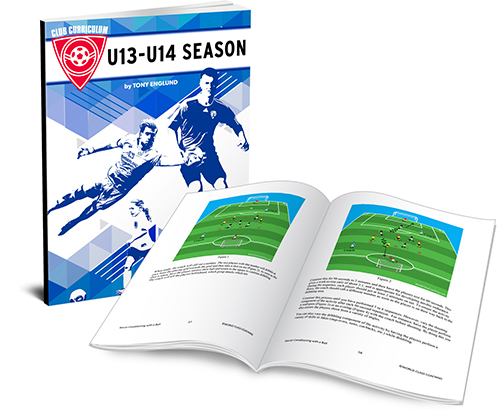
TABLE OF CONTENTS
Part Four
ATTACKING SESSIONS
ABOUT THE AUTHOR
Training Session #18: Cross and finish 1.
Introduction: With the bigger field and increasing complexity of opposing defenses, many goal-scoring opportunities will come through stretching the opposing back line and serving the ball for on-running players to finish. This session looks at the technical nature of crossing and introduces basic runs to finish.
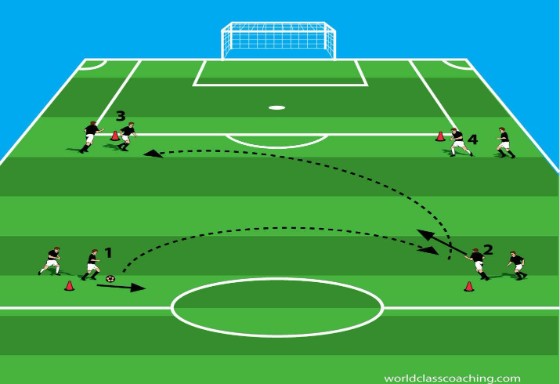
4 corners long passing - ½ field
Divide the team into four groups. Each group forms a line behind one of four cones placed to form a 20x20 yard grid in the center of one end of the field. Keep a ball supply at one cone. Explain that this is a passing sequence warm-up that will be expanded into a long passing exercise. The first player in line with a ball (1)passes straight ahead to the first person (2) in line at the cone opposite her line. She then follows her pass and goes to the end of that line. The player receiving the ball at the second cone then passes at a diagonal to the first player in line at the third cone ( 3 - see diagram) and follows her pass.
The player at the third cone plays straight ahead and then follows her pass. Finally, the player at the fourth cone (4) plays diagonally back to the start and follows her pass and the sequence begins again. This is a useful warm-up to emphasize passing accuracy, quality receiving (players should receive the ball using their first touch to set up their pass with the second touch, which is to say that their first touch should push the ball in the direction that they intend to pass), and running after the pass.
Progression:
• play for two minutes, and then see if the players can keep two balls moving at the same time.
• after two more minutes, move the cones back to create a 25x25 yard space. The exercise remains the same, except that now the passes are longer and the coach can dictate what type of serve (driven, lofted, chipped) is required. The coach should require players to alternate the foot they use for passing (in the short and long phases).
• once the players have the pattern for the long pass, introduce a second ball to apply some time pressure and also more repetition for the players.
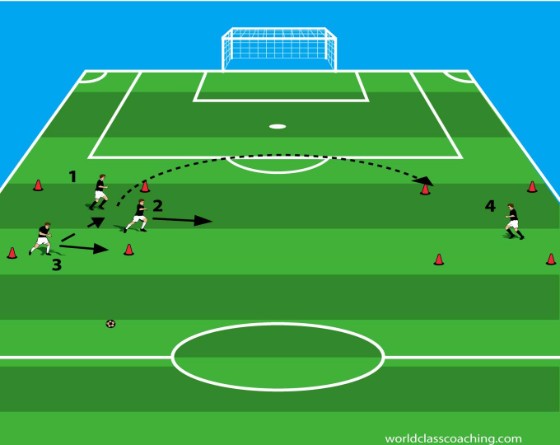
Fitness long passing - 10x10 grids (spaced)
Players work in groups of four with a ball. Place one player (4) in a 10x10 yard grid, and the other three in a 10x10 yard grid that is set up about twenty-five yards (adjust to fit the abilities of the players) from the other grid (see diagram). Demonstrate with one group. In the grid with three players, identify a single, passive defender (2). This player is to play at walking pace to start. The remaining two players (1,3) are to pass the ball at least three times before one of them plays a long pass to their teammate in the far grid. Once the ball has left the grid, the player making the long pass (1) stays in the grid, while the other attacker (3) and the defender (2) race to the far grid. The last player to arrive in the new grid becomes the defender, while the other two players are attackers.
The attackers move around the grid to connect three passes while the defender provides passive resistance. Then the long pass is made and the sequence continues. It is important that players understand the changing roles before commencing the exercise. This exercise provides long passing practice, highlights the importance of providing early support to the ball when the field is changed, and also raises the players’ fitness by requiring frequent, short sprints. Play for five minutes.
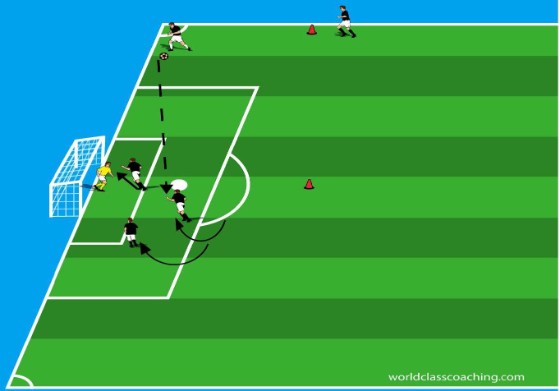
Simple cross and finish - ½ field
This exercise is designed to create a very simple environment to train the basic patterns involved in crossing and finishing the ball. Place two players with a ball supply near the right touchline, near the top of the large box. The
goalkeeper will be the only defender in the exercise at this point. The remaining players are divided in groups of three and gathered outside the top of the “D.” The first thing to establish is the running patterns and crossing cues for the wide player as she prepares to serve the ball.
• at first, quality runs and service are more important than speed.
• the server should make all of her runs to the end line at first. The idea here is to build into the players’ understanding that this run creates a lot of trouble for the defense, as they are forced to retreat deep and may either lose track of runners or the ball and they are often poorly positioned to clear a cross.
• the server’s last touch before crossing should be in the direction of the goal and not the end line. This is referred to as “turning the corner.” Many young players serve a lot of crosses behind the goal, often because they are trying to catch up to a touch that has them facing the ball as it rolls toward the end line. If the last touch before crossing is in the direction of the goal, the player will be able to then look up at the target area and select a target for the cross, turn her hips and shoulders toward the goal, and plant her non-striking foot pointing toward the goal as well. When these cues are followed, the server has a better chance of executing a successful cross.
• also point out that the best crosses are often on the ground and cutting back across the defense. In other words, the ball is played back up field, into the area between the small box and the penalty kick mark (on the large field, this is referred to as the “second six”).
• the other point of focus here is the runs to get onto the end of the cross. There are several stages of development in learning to finish crosses, and the most basic imprint is desired here.
• impress upon the runners the tactical importance of creating space and timing the runs. The most difficult aspect of this process is getting the players to hold their runs until the appropriate time. If players arrive in the target areas before the ball has arrived, they are much easier to mark and the effectiveness of the movement will be very limited under pressure. It is often useful for the coach to hold the runners and release them a bit late so that they learn to be more patient.
• target areas. In 8v8 soccer, there will rarely be more than three targets for a given cross. Therefore, it is useful to teach players at this early stage to sort out runs to three critical areas.
1. Near post. The first player in will crash the near post
2. The second player in will arrive in the second six at the same time as the ball.
3. Back-post. This player is the last player to arrive and is typically the back-side midfielder or forward. It is useful to emphasize that this player’s purpose, particularly at the younger levels, is to assure that any ball that passes by the first two targets and the defenders is kept “in the mix,” which is to say that she cleans the ball up by either finishing it at the back post or pushing the ball back into critical space if the cross has passed out of the target areas. The most common concern here is the that back-post player will want to close too tight to the goal, when she is often best served by remaining wider and higher until after the ball is hit and it becomes clear that she needs to adjust her position. This run becomes very important as players become more adept at serving lofted crosses to the back post, where the far target can get in to finish.
• bent runs. Players will want to run straight to the goal. This choice makes them easier to mark and also gives them poorer finishing angles to the ball, an element that is critical to building success and confidence in young players. Instead, players need to be shown how to bend their runs away from the ball as the crossing run is developed. This forces the defenders to give attention to either the ball or the player, but makes it difficult to do both. Also, as the players then close at speed into their target positions, their collective body positions will be “open” to the ball, meaning that the ball will come straight at them (as opposed to from the side), giving them more finishing options and a better look at the ball (which gives them the ability to adjust their runs on approach to the ball as well).
Improving quality. Here are some additional suggestions for improving the quality of basic crossing and finishing as the exercise is developed.
• allow play to continue as long as the ball is knocked down by one of the runners inside the large box. This way, young players are not compelled to finish with the first touch as they learn to deal with balls driven toward the front of the goal.
• begin the exercise with a pass from one of the runners in the center to the flank runner. The idea here is that most crosses are set up by a ball served to the runner from a central position, so the pattern is expanded to simulate a realistic opportunity to set up a cross.
• create teams and keep score. Each server and group of runners are a team (and the goalkeeper is her own team, earning points for quality saves) and each team earns a point for scoring (or if there are not a lot of goals in the early stages, give a point for a first-time shot that is on the face (i.e. would be a goal but the goalkeeper made the save) and two points for a goal.
• be sure to switch the service to the left side (if there are enough players, arrange service from both sides and alternate the source of the runs and crosses).
• also be sure to alternate the servers so that all players have the opportunity to serve and learn the runs to goal (players should also alternate the runs they make to goal (i.e. back-post, near-post, etc.).
• encourage players to serve crosses on the ground first (to an open target), and then encourage them to try playing a long cross in the air to the back post area as they get more comfortable.
• train all players to communicate. The server should visually and verbally identify her target and the runners should learn to demand the ball from the server.
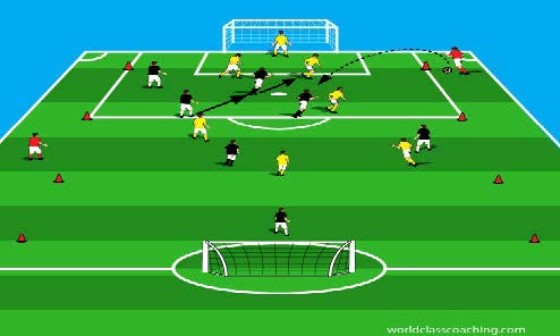
6v6 with neutral crossers - ½ field
Play 6v6 with neutral crossers and goalkeepers. The crossers are required to stay in the neutral lanes on the flanks (see diagram) and no other players may enter that space. Re-starts come from the goalkeepers (place a supply of balls in each goal). The only means of scoring a goal is directly off of a cross, so teams will need to work to play in to the crossers to set up scoring opportunities. This is a good environment for training the runs for the targets and also for building the quality of the crossing. The coach should encourage early service wide to the crossers (even from the goalkeepers at re-starts) to create numerous crossing situations. Play for two minutes and then change the crossers. Crossers need to make end line runs before crossing. Coach the runners as above. Keep track of score.
6v6 to full-sized goals - full field
Play 6v6 to goals. For the first ten minutes, give three points for a goal scored as a result of a cross and one point for all other goals. Then remove the three point bonus and let the players play.
Training Session#19: Cross and Finish 2
Introduction: This session takes a more in-depth look at the nature and timing of runs to finish crosses.
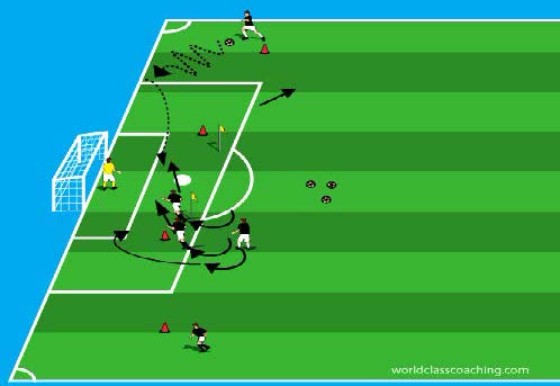
Cross and finish - 1/3 field
Runners gather in groups of 3-4 twenty-five yards from goal. The group has a large ball supply. Crossers are located at the touch lines on both sides eighteen yards from goal. In the first phase, the goalkeeper provides the only defense of the goal. The ball is served by one member of the finishing group ahead of the crosser on either flank. The crosser runs the ball to the end line and serves a cross for the runners to finish. Each goal earns a point for the crosser and for the group of finishers. Keep track of the score throughout the exercise. Allow each sequence to continue as long as the runners’ touches move the ball in the direction of the goal.
Variation:
• require one-touch finishing.
Progression:
• setting the runs. Place flags 15 yards from the goal line and even with the top corners of the six-yard-box. Also mark a send 6-yard box (as shown), doubling the standard box markings.
Coach:
• end line crosses. Explain to the crossers that taking the ball to the end line before crossing accrues the following benefits:
1. the defenders are compacted back into their own goal area.
2. by attacking the end line, the crosser often forces the goalkeeper and defenders to either focus on the ball or the runners.
3. crosses from the end line can be made at angles that are easier for runners to intersect and finish.
4. finally, crosses from the end line create a visual timing cue for the runners that maximizes coordination.
• target zone for finishing. Coach the group to look to serve and finish in the second six. This area is far enough from goal to discourage the goalkeeper from attempting to field the cross, and yet close enough to allow runners to finish first-time. Additionally, defenders compressed back into their own six-yard box will have difficulty defeating oncoming runners in dueling for the ball in this space.
• tactical runs. After playing the initial ball for the crosser, the finishers must now run around the away-side flag before closing on the goal. The run away from the ball both allows the runners to time and choose their angle in closing on the cross and also furthers the likelihood that the defenders and goalkeeper will not be able to track both the runners and the ball.
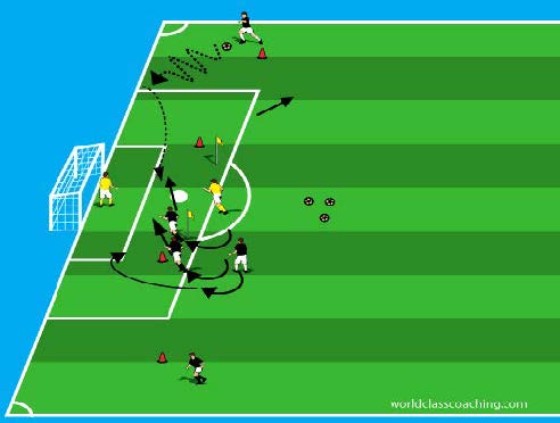
Progression:
• add a single defender. Instruct the defender to start in the “D” and then recover as the ball is played to the flank. The defender should, for the purpose of this exercise, mark one of the runners.
Coach:
• frame the goal with the attacking runs. The diagram above outlines the areas to be attacked in a crossing situation. Thus, the first runner to round the flag is tasked with sprinting to the near post area to finish a short service. This player also focuses on assuring that the goalkeeper is not allowed to handle the cross. The second runner stays up high, looking for a cross cut back into the second six-yard box. The last runner to round the flag gets into the space beyond the back post, completing the ‘framing’ of the goal.
• service types. Crossers must learn to select the type and texture of the service. On reaching the end line, the crosser should round the corner, taking a touch toward the goal and then quickly surveying the runners’progress and the defender’s location to see which runners are un-marked. The following are guidelines for the type of pass to be played to the various runners/zones.
Near post: Driven ball.
Second six: A sharp pass on the ground or driven ball for the finisher to run onto.
Back post: Lofted ball to cut out the goalkeeper and defenders.
Progression:
• add a second defender. The defenders continue to make recovery runs from the “D” and they now mark two of the three attacking runners. The crossers continue to try to pick out the open player in each sequence. The ball is live as long as it remains inside the 18-yard box.
8v8 + neutral crossers - ½ field
Close the session with an 8v8 game plus goalkeepers and neutral crossers. Play to full-sized goals on ½ field with a 10 yard lane on both flanks where only the neutral crossers can play. Goals can only be scored off of crosses from the neutral flank players. All restarts (no corners, goal kicks or throw-ins) come from the goalkeepers. If the coach wants to make flank service more difficult to set up, do not allow the goalkeepers to play into the neutral crossers. This will compel both teams to invest in more build-up play.
Coach:
• quality service from the flanks, including both good technical crosses and intelligent selection of the type and location of the service.
• well-timed and structured attacking runs to goal and aggressive finishing efforts on each cross.
Training Session#20: Overload Attacking Training
Introduction: Overload attacking situations are environments where the attackers are numbers-up. The exercises in this session require the attackers to make decisions about the speed and direction of play when confronted with high pressure defending on the way to goal. Encourage defenders to vary their decision-making and thus compel the attackers to deal with the full range of defensive responses.
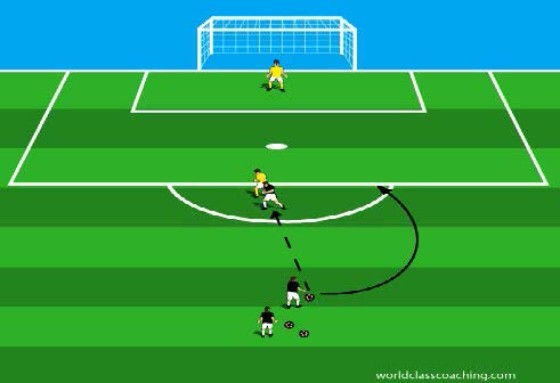
2 v 1 Overlap - 1/3 field
Attackers work in pairs, with one player starting with the defender in the “D” and the other prepared to serve the ball from ten yards further up field. The pass to the striker initiates the duel, with the striker compelled to decide whether to hold the ball and wait for the oncoming overlapper; spin off and go to goal herself; use the overlapper as a decoy, attempt to face-up and play the overlapper in or lay the ball off immediately and create off of the ball. The defender should vary her pressure and positioning to encourage the attackers to make conscious and good decisions. Players change roles with each restart. This environment challenges players to read their options and make good decisions under pressure in a situation replicated often in game situations.
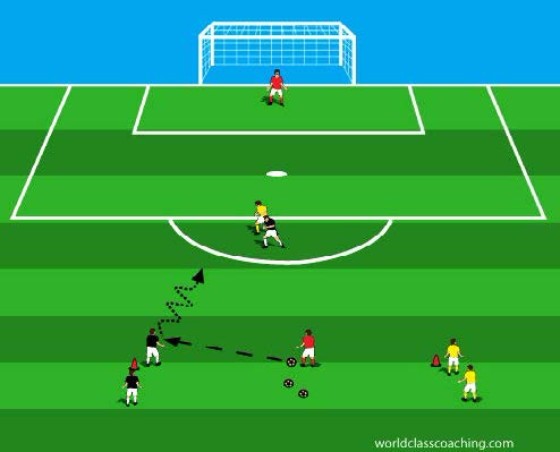
2v1 Reaction - 1/3 field
Once again, two players in different color vests wait in the “D.” This time, there are also lines to either side of the center service area (one in each color). The coach initiates play by passing to the first player in either line. The player in the “D” with the corresponding color becomes the attacker and the other player is the defender as the players play 2v1 to goal. The attacker receiving the pass from the coach then takes the place of her teammate in the “D” as play continues.
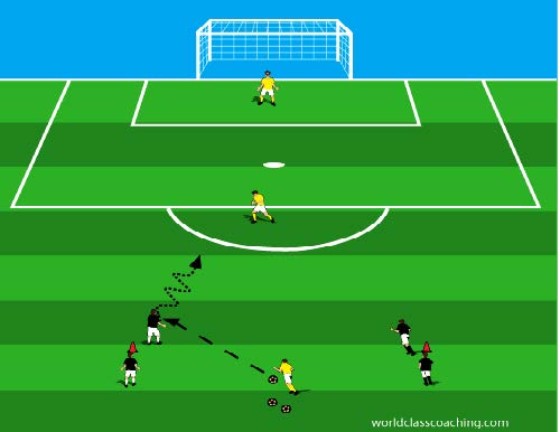
2v1 +1 Recovering - 1/3 field
A defender serves to either of the attackers and then sprints to recover. An additional defender waits in the “D.” The attackers have a 2v1 to goal if they play quickly. If the defenders win the ball, the duel ends.
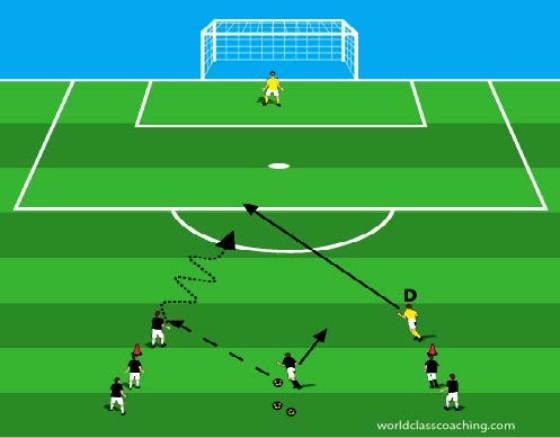
2v1 Choice - 1/3 field
Players work in groups of 3. The server can play to either of the targets. The other player becomes the defender and the duel proceeds (2v1) to goal. Change roles with each restart.
2v2 Games - 20x25 yard grids
Organize 2v2 games to small goals. To begin, one defender has to take a knee when her team loses possession and remain there for three seconds. This will create 2v1 opportunities for the attackers. After 5 minutes, remove the restriction and let the players play.
Training Session#21: Finishing 1
Introduction: This session features a collection of effective finishing exercises. As such, it is not a free standing session per se, but any combination of these exercises would fit well into a session on finishing.
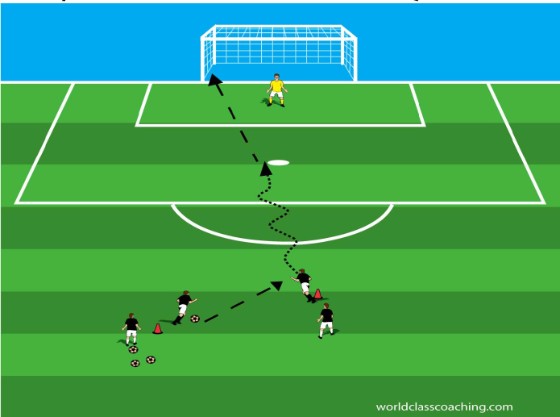
Pressure shooting - 1/3 field
Two lines form at the cones 30 yards from goal as indicated in the diagram. Note that the cones are staggered to give the attackers an advantage. The first player in the defending line passes to the front foot (or into space in front of her) and then the defender pressures and attempts to win the ball from the attacker, who sprints to finish. If the defender wins the ball, she tries to score. After the shot is taken, the attacker retrieves the ball and jogs back to and joins the defender’s line.
The defender joins the attackers line. Encourage the attacker in this exercise to take a straight angle with speed to the goal (there is a tendency for the attackers to veer to their right to avoid pressure) and adopt a good shooting angle. The attacker should also get a good look at the goalkeeper’s position after her set up touch and see if she can shoot (low, back post is best) while the goalkeeper is trying to close her down (catch the goalkeeper moving forward).
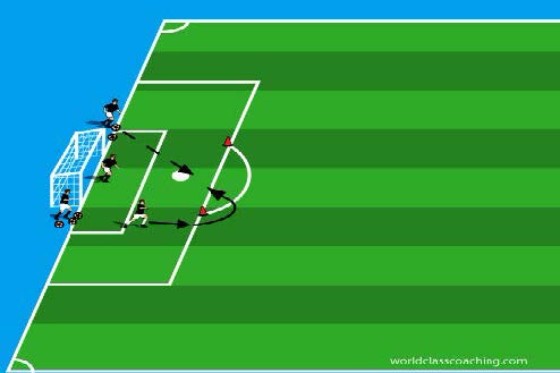
Pass and Shoot - goal box area
Create two groups and have them collect balls just outside the posts. A player from one team runs around the cone 10 yards from goal and then receives a pass from the opposing line. The attacking player takes a touch to set the ball and then takes a shot at goal. Then the passer becomes the attacker. Urge players to remember to move to their next role quickly and to restore the ball supply and change lines after shooting. Keep track of goals scored for each team.
Variations:
• one-touch shooting
• give the goalkeeper points for great saves
• rebounds are live
• only goals scored in the air count
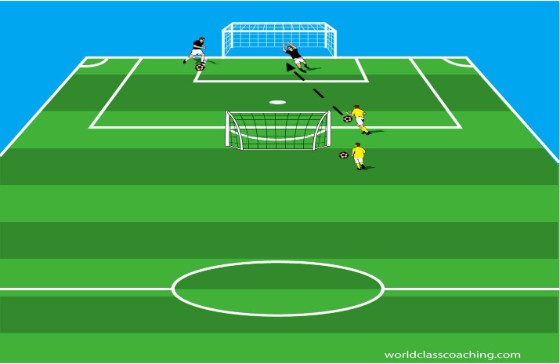
Shoot-keep-retrieve
Divide the team into two groups. Put each group at the side (opposite sides – see diagram) of a goal. Players take turns shooting the ball at the other goal, then playing goalkeeper for one turn and then getting a ball and getting back in line. Players may not cross the center line between the goals before shooting. Adjust the grid size to be sure that players are not too close (for safety reasons) or too far away (shots are not reaching the goals). For U8 players, the goals should be about 10 yards apart and 3 yards in width. Encourage players to shoot on the ground and to use their laces or the inside of their foot to strike the ball.
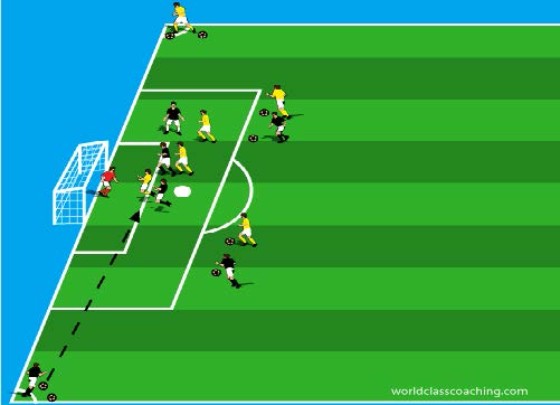
Team Trains ‘Keeper - goal box area
Create two equal teams. Each team places three players in the goal box area and one crosser in one of the corner areas. The remaining players get a ball supply and spread out across the top the 18-yard box. The goalkeeper calls out names of servers (players on the top of the 18 can shoot or pass and players at the corners serve crosses) for each restart. When a player at the top of the 18-yard box opts to shoot, the players inside the box must clear the area of the 6 yard box for the goalkeeper. The ball is live as long as it remains inside the 18-yard box. Play for five minutes and then rotate servers and active players.
Training Session #22: Finishing 2
Introduction: Many coaches like to plug in 10 minutes of finishing near the end of every training session and these exercises require limited set-up and provide a variety of efficient, sometimes functional finishing environments. This session features a variety of effective finishing environments that players and coaches consistently cite as being among their favorites.
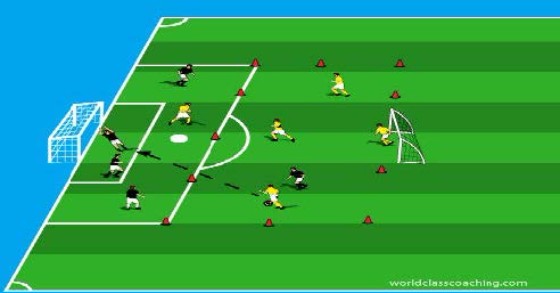
Long-range finishing game - 1/3 field
Utilize an area twice the size of the penalty area (36x44 yards). Divide the group into two teams. Each team places one player in their attacking half of the field and four in their defending half. The players must remain in their respective halves of the field. If the player in the attacking half wins the ball, she cannot shoot, but rather must lay off the ball to the back half of the field for a long-range shot. Restarts come from the goalkeepers. Play for three minutes and then rotate the lone player in the attacking half for both teams.
Coach:
• technical long-range finishing.
• setting up the long range shot. In particular, players should learn to think carefully about the longer preparatory touch required for a driven ball from distance, and for the types of angle, pace, and placement required in the set-up passes leading to a shot at goal.
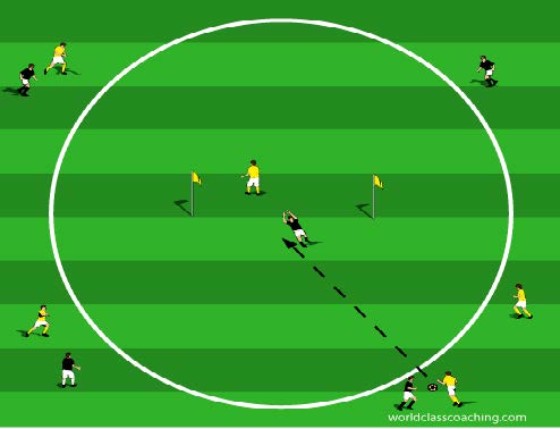
Two-sided goal finishing game - 1/3 field
Divide the group into two teams. Put a goalkeeper on either side of a flat, full-sized goal (or two flags placed to form a goal) at the middle of the center circle. Teams can score on either side of the goal. No players other than the goalkeepers are allowed inside the center circle. The goalkeepers restart after gaining possession or a goal by throwing the ball anywhere in the area. The goalkeeper tandem receive a point for every clean save.
Variations:
• attackers can enter the area for rebounds only.
• attackers are allowed inside the circle once the ball has entered the area.
• attackers are allowed into the area but goals can only be scored by head or volley off of a serve.
Rapid Fire - 1/3 field
Divide the group into two teams. One team, each with soccer balls, dribble in a grid 30 yards from goal. One attacker is posted 20 yards from goal and serves as a wall-passer. This attacker calls out the names of teammates who pass into her feet, receive the return pass and try to finish before crossing the penalty spot. The defending team post two supplemental goalkeepers on the posts of the goal. These players must keep one hand on the back of the post and cannot use their hands to save the ball. The remaining defenders are arrayed well behind the goal. They can earn a point by receiving in the air errant shots over the goal by the attackers and the completing three juggles before the ball hits the ground. Play for two minutes and then rotate the supplemental goalkeepers. After three rotations, the two teams change roles.
Variations:
• when a goal is scored, one or both supplemental goalkeepers must run out and touch the line on their near side of the six-yard box (meanwhile, the attackers continue to try to finish).
• defenders behind the goal get a point for heading any errant shot.
• vary the service (i.e. toss balls to be volleyed) and distance (or striking foot) for the shooters.
Training Session#23: Technique Olympics
Introduction: This series of technical challenges can serve as a fun team competition or as a periodic assessment of players’ technical progress.
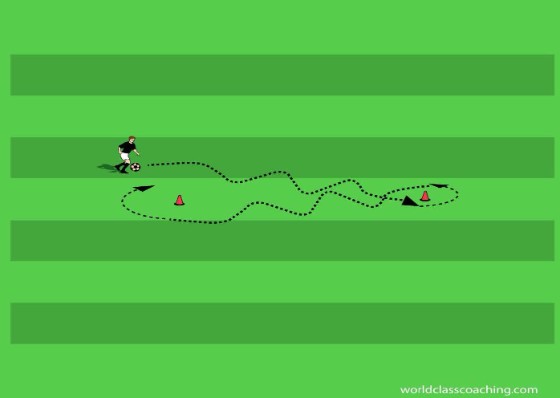
Figure 8 Dribbling - 10x3 yard areas
The player dribbles in a figure 8 pattern around the cones, using the inside of the foot for each turn. Which player can complete the most circuits in one minute?
Progression:
• all turns are made with the outside of the foot.
Body part juggling
Each player has a ball. The challenge here is to try to utilize as many body parts from the list below in each juggling sequence. Players earn a point for every different surface used in each sequence, but not for redundant use of a given surface.
1. head.
2. left shoulder.
3. right shoulder.
4. chest.
5. right thigh.
6. left thigh.
7. top of right foot.
8. top of left foot.
9. inside of right foot.
10. inside of left foot.
11. outside of right foot.
12. outside of left foot.
13. right heel.
14. left heel.
Which player earns the best score?
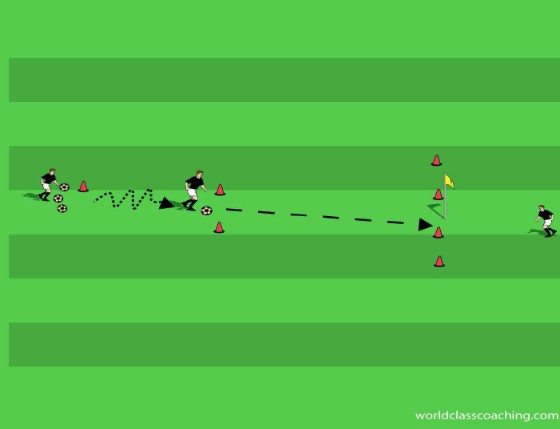
Passing accuracy - 10x10 yard areas
The active player dribbles to the cone line and passes, attempting to push the ball between the flag and the nearest cone on either side (2 points). A pass between the first and second cone on either side is worth a single point. Any pass outside of the flanking cones does not earn a point. The active player then runs back to retrieve another ball and tries again. The two resting players are responsible for maintaining a ball supply for the active player. Play for one minute and then change roles.
Variation:
• all passing is with the ‘off’ foot.
Which player earns the highest score?
Head juggling
Each player has a ball. Which player can complete the most consecutive headers in one sequence? Play for one minute and check scores.
Variation:
• tally total headers over one minute.
Long passing accuracy - Two 10x10 yard grids twenty yards apart
Players work in pairs with a ball. One player stands in each grid. Players earn a point for every ball they can long pass in the air into their partner’s grid. Play for three minutes.
Variations:
• all passes must be made with the ‘off’ foot.
• give another point for proper receiving touches that keep the ball inside the receiving player’s grid.
Training Session #24: Attacking Set Plays
Introduction: For any competitive team, regardless of the chosen system of play, effective attacking set plays are critical to the team’s success. This session is not intended to be a free-standing training session, but rather a collection of creative and effective throw in, corner kick, direct and indirect free kick plays.
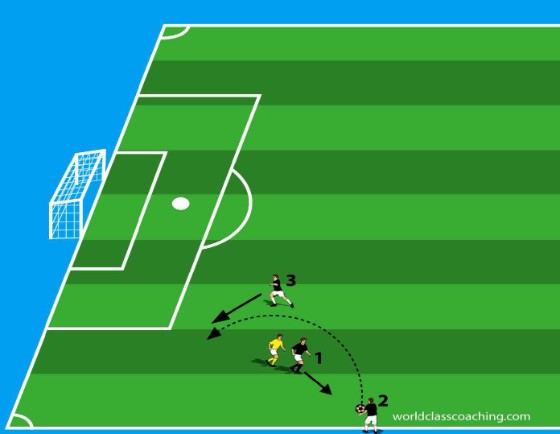
Decoy throw-in play.
Player 1 checks back toward the ball while player 3 sprints into the space behind player 1 as player 2 throws the ball for player 2 to run onto. Player 1 needs to be very demonstrative in demanding the ball as she checks to the ball so that the defender will be pulled out of position and player 3 can find space to run into.
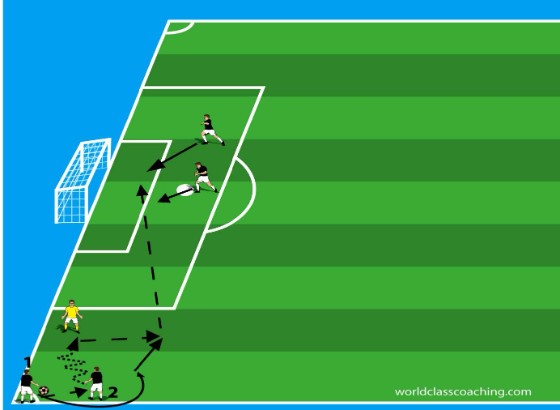
Short corner kick play
Player 1 and player 2 are at the corner. Player 1 passes to player 2 and then overlaps her. Player 2 dribbles at the defender. Player 2 can either pass to player 1 or fake the pass and dribble past the defender. Either way, the ball is crossed for the coordinated runs before goal, or shot at goal if the runner can achieve a good angle and distance from which to attempt to score.
Considerations:
• if an opponent is closer than ten yards, the players should ask the official to set the proper distance before commencing their movement.
• note that if the opponents send two players to defend this play, the attackers change the play to serve a ball into the area.
• a useful variation to this play is to place a single player at the corner to start and then have a runner come from the crowded area in front of the goal and check to the ball to play a 1-2 with the server. In this way, it is both easier to disguise the short corner and also create a better angle and distance for the serve into the area.
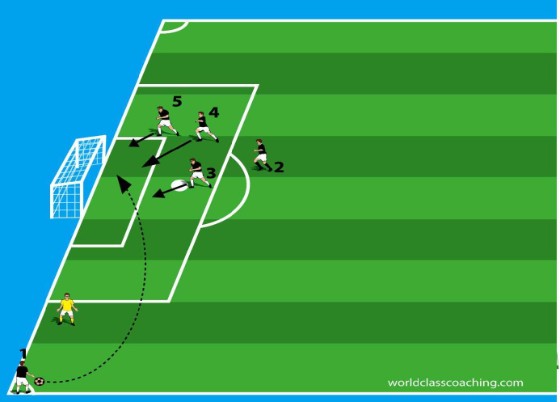
Wave corner kick play
Player 1 is at the corner. Players 2, 3, 4, 5, and 6 gather at the top of the box and just beyond the back post. At a signal from player 1, the runners close on the goal and finish the serve from the corner.
Considerations:
• the starting position for the runs can be varied. Some teams group the runners together, making the individual players difficult to track. Other teams put the players together but then have them mix about until just seconds before the kick, making the runners even more difficult to sort out. Finally, some coaches like to send the runners in stages, hoping to drag defenders out of position. Regardless, it is important the coach find a rhythm and pattern that is predictable and successful for the team.
• the coach can set the runs to meet the anticipated service to a particular zone (often the back half of the goal and 5-7 yards from the goal). It is advisable to have at least one runner getting into the near post area to find a short or low serve (advanced teams often target this player to flick the ball to the targets at the back post). Similarly, one runner should attempt to get to the goalkeeper to disrupt her concentration on any ball served to a point where she can play it), and one player should seal off the area outside the back post to frame in any ball that gets through the area.
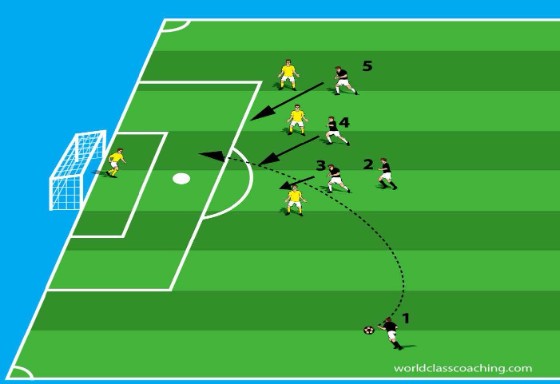
Distance free kick play
This is the classic play to take advantage of a free kick opportunity from a distance beyond which a direct shot at goal can be attempted. Player 1 is at the ball. Several target players line up along the defensive restraining line. Player 1 serves the ball behind the defensive restraining line, but also far enough from the goal to prevent the goalkeeper grabbing the serve, for the runners to find and finish.
Considerations:
• the runs should be coordinated in such a way as to assure that a player gets end-line to prevent the ball going out for a goal kick and at least one player should make an effort to challenge an advancing goalkeeper for the ball as well.
• the runners should not all start on the defensive restraining line where they are easy to mark and where their runs can be disrupted by the defenders. Rather, it is useful to have some runners start in wider positions (and several yards on-side) and approach the restraining line at full speed (and out of the vision of the defenders as they focus on the ball) as the ball is served.
• another tactic to frustrate markers is to have a runner(s) stand in an off-side position during the set-up of the play and then check sharply on-side just before the ball is struck.
• finally, at high levels teams often run switches, with players crossing (and, cynically, picking off defenders) as they run, making it difficult to isolate a particular defender on a dangerous attacker.
Direct free kick
If the ball is close enough to finish, most teams at this age select a player to shoot directly from the restart. If there is a concern about the opponents sending a player from the wall to block the shot (‘bullet’), the team can send a player to run over the ball to draw out the bullet and then point out the infraction to the official. If there is an ongoing concern in this regard, the team can send multiple players to the ball and have them discuss who will run over and who will shoot the ball (perhaps the first player onto the ball strikes it).
Variations:
• for indirect kicks within shooting range, many teams will have the player running over the ball touch it, thus setting up the direct shot from the second player.
Training Session#25: Defending set-pieces.
Introduction: Defending set plays requires considerable preparation, first by the coach in deciding the framework with which the team will confront opponents’ efforts to finish and then in the team setting, to assure that every player instinctively understands their roles and will react properly and consistently under pressure. This session lays out the possibilities for defending at set-pieces, and also suggests ways to comb defending set-pieces into the training environment.
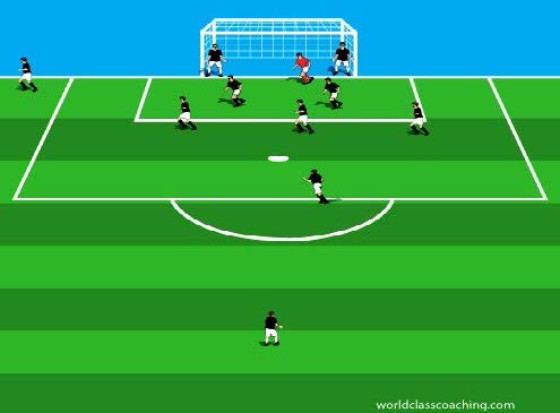
Defending corner kicks - 1/3 field
Corner kicks offer a very strong chance to score at any level, and the coach preparing her team to defend in these situations must first answer several important questions:
1. Will the team employ zone or man-marking or a mix?
2. How many players will defend?
3. How well does the team defend in the air (the answer to this question impacts the answer to #2)?
4. How big an area can be assigned to the goalkeeper (i.e. how strong is the goalkeeper in the air and handling the ball in traffic)?
5. Other considerations (opponents’ efficiency at corners, weather, game situation).
Recommendation:
• deploy a mix of zonal defending and man-marking as shown, placing players at each post (note the near-side defender’s up-field-facing position before the kick, freeing the goalkeeper’s vision. If instructed to clear the ball by the goalkeeper, she steps out and plays the ball away); the center backs and the goalkeeper to control the six-yard box; the midfielders are placed in a stacked zone across the top of the six-yard box. Any ball that would fall in front of any one of them is their responsibility. One forward is responsible for dealing with any potential short corner (many teams send one player to the corner to deal with this possibility and distract the kicker. It’s even better to send a second player- a midfielder- to play 2 vs. 2 against a short corner). A midfielder or the extra forward(s) can be detailed to mark a particularly dangerous opponent. Most teams leave at least one player near midfield to start counters and also to keep as many of the opponent’s back line as possible from joining in the corner kick.
• train a confident, aggressive mentality into the group for defending corners. Playing passively will lead to goals being conceded, whereas a loud, active and determined defending group provides an intimidating environment for the attackers and also gives the defenders a psychological sense of purpose.
• clearing out. The team hunts the ball once the serve is struck. When the ball is played away from the goal, all but the two backs on the posts must pursue and pressure the ball. When the ball leaves the box, the two players on the posts sprint forward. Keeping them in gives extra protection in the goal area while the ball is still in a dangerous position. However, when the ball leaves the area, the danger decreases and the retention of those players on the posts both eliminates the possibility of an offside call against the attackers and detracts from the width of the defensive back line in transition.
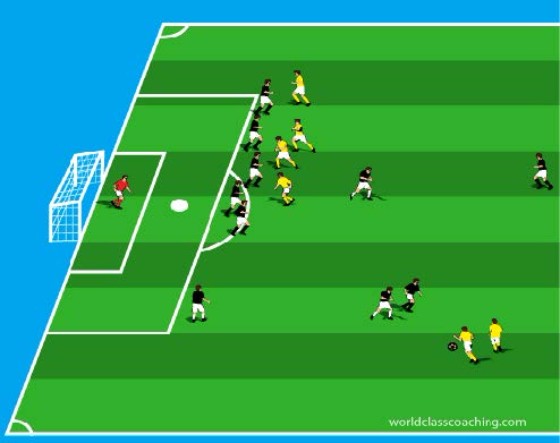
Defending direct or indirect free kicks: Beyond shooting range - 2/3 field
When the opponent earns a free kick from beyond shooting range, the defending group may still employ a small wall (1-2 players) to distract the server and additional players may remain in the area to deal with short options for the attackers. The remainder of the team organize a restraining line to develop space for the goalkeeper to handle a long serve toward the area. Players along the restraining line should get shoulder-on with an attacker, with the idea that the contact will wreck the timing of their run into the area and also allow the defender to arrive first. If possible, at least one central defender should be left free.
Some teams, particularly at the youth level, prefer to have this player leave the line and run into the area just before the ball is struck to give the player an advantage in the race to the ball. This decision may wreck the offside protection offered by holding the line, but it also gives the defender a major advantage. Regardless, the goalkeeper must make an early call as to whether she will handle the ball or if the team will need to clear the serve, and once the ball is cleared, the entire team must work to get forward and recover their shape as quickly as possible.
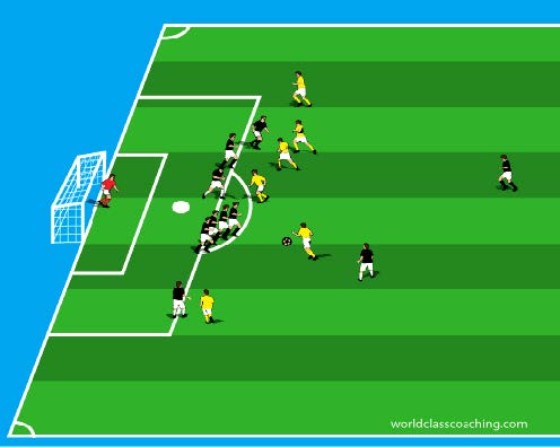
Defending direct or indirect free kicks: Shooting range - 1/3 field
Direct free kicks from around the edge of the 18-yard box and at angles where shots can be taken require special treatment from a defensive perspective. The coach should give parameters for the number of players to be placed in the wall (from 1-2 for wide angles and up to 4-5 for shots from straight on). Typically the midfielders and/or forward(s)form the wall. The coach can instruct the goalkeeper to arrange the wall or a forward can perform the same duty so that the goalkeeper can focus exclusively on the ball. Either way, the wall should be arranged with the tallest player on the near post (this area is most in danger, as the goalkeeper begins in the back half of the goal) and shorter players filling out the line.
It is critical that the coach work out the process for the placement of the wall so that it can be done in just a few seconds under pressure. If the goalkeeper will set the wall, the end player (tallest) should either turn and face her or look over her outside shoulder to see her instructions, all the while grasping the next player in the wall to assure that movement is synchronized. The end player, as a rule, should be at least the width of one person outside the post to deter attempts to bend the ball around the wall. The defenders mark opponents around the wall, picking up the most dangerous players first and holding a line nearly as high as the wall itself (to minimize traffic for the goalkeeper in trying to make the save).
Tactical considerations:
• in the modern game, most defending teams put a player(s) 2-3 yards in front of the ball to wreck any idea of taking the kick before the wall can be set. By the rules of the game, this is meant to be rewarded with a yellow card, but it is almost universal that there is no card and the attacker requests the proper 10-yard spacing. Once the official steps in to set the wall at the proper distance, play is only restarted with the referee’s whistle.
• use of a ‘bullet.’ Although more common in indirect free kick situations, some teams send a player off of the end of the wall running at the ball (‘bullet’) just before it is struck. Once again, technically-speaking this should result in a yellow card, but most often it results in a blocked kick. Many coaches only employ a ‘bullet(s)’ only in indirect kick situations.
Indirect free kick in the area - 18-yard box
Occasionally, a team will concede an indirect free kick in the area. This is a very dangerous situation, particularly if the placement of the ball is close to the goal mouth (as shown). In this case, many coaches place the entire team on the goal line, splitting the wall around the goalkeeper. Remind players that since this is an indirect kick situation, the opponents will need to take a touch before shooting. When that first touch is taken, the entire wall (some coaches leave players on the posts) sprints forward, keeping in their lanes, hoping to block the shot. Indirect kicks from sharp angles can be played more like a corner kick, with defenders on the posts and a combination of zone an man-marking in front of goal.
Sources and Recommended Reading
Alagich, Richard. Soccer: Winning Through Technique and Tactics. New York, NY: McGraw-Hill, 1996.
Dorrance, Anson. World Class Coaching Clinic Session.
Fairclough, Paul. Soccer Strategies. Buffalo, NY: Firefly Books, 2009.
Fleck, Tom, and Ron Quinn. The Baffled Parents’ Guide to Great Soccer Drills. Camden, ME: Ragged Mountain Press, 2002.
Galustian, Alf and Charlie Cooke. A New Era: A Coerver Coaching Masterclass Series. Sportsmethod, 1998.
Gregg, Lauren. The Champion Within: Training for Excellence. Burlington, NC: JTC Sports, 1999.
Harrison, Wayne. Full Season Training Program: A Complete Season of Training Sessions for a Competitive U12 Team. Leawood, KS: World Class Coaching, 2007.
Kormelink, Henny and Tjeu Seeverens. Developing Players the Dutch Way. Spring City, PA: Reedswain, 1996.
NSCAA. State Diploma. Course materials.
NSCAA. Regional Diploma. Course materials.
NSCAA. Advanced Regional Diploma. Course materials.
NSCAA. Coaching Soccer. Edited by Tim Schum. Indianapolis, IN: Masters Press, 1996.
Rees, Roy. The Manual of Soccer Coaching. Spring City, PA: Reedswain, 1995.
Rees, Roy and Cor Van Der Meer. Coaching Soccer Successfully. Champaign, IL: Human Kinetics, 1997.
Success in Soccer (DFB). Basic Training:Techniques and Tactics for Developing the Serious Player. Munster, Germany: Philippka Sportverlag, 2002.
Success in Soccer (DFB). Modern Youth Training: The Complete Guide to Soccer for Kids. Munster, Germany: Philippka Sportverlag, 2006.
Stoop, Tino. Coaching Under 12’s: A Complete Coaching Course. Spring City, PA: Reedswain, 2003.
Tipping, Jeff. NSCAA Convention Session.
United States Soccer Federation. Soccer: How to Play the Game: The Official Playing and Coaching Manual of the United States Soccer Federation. New York, NY: Universe Publishing, 1999.
Wein, Horst. Developing Game Intelligence. Spring City, PA: Reedswain, 2004.
Wilkinson, Roger, and Mick Critchell. 300 Innovative Soccer Drills for Total Player Development. Spring City, PA: Reedswain, 2000.
About the Author
Tony Englund is the Assistant Director of Coaching at St. Croix Soccer Club. Tony has earned more than a dozen diplomas from the National Soccer Coaches’ Association of America, including the Premier, National Goalkeeping and Director of Coaching awards and he serves as an Associate Staff Coach for that organization. Tony is a frequent presenter at high-level coaching clinics. He has served as Director of Coaching and Player Development with three Minnesota clubs and has more than twenty years’ experience as a successful club, high school and college head coach. His teams have repeatedly earned promotion to the highest levels of state and Midwest Regional League play and won multiple state championships, premier league titles and consistent regional rankings. He is the author of nine books published by WORLD CLASS COACHING.


